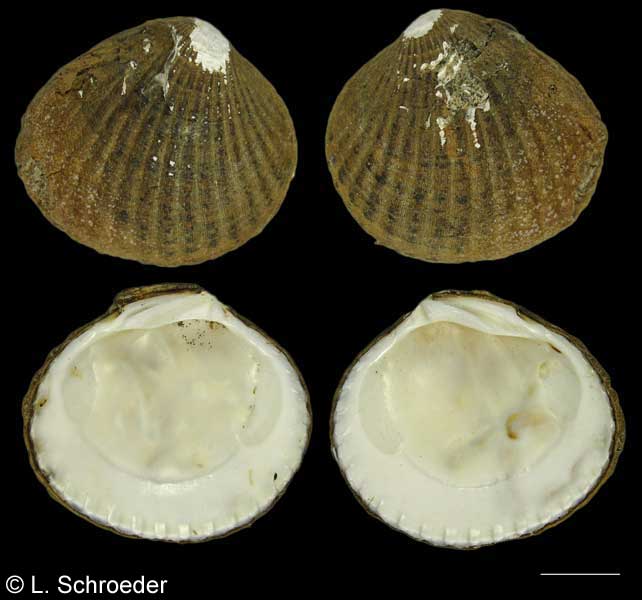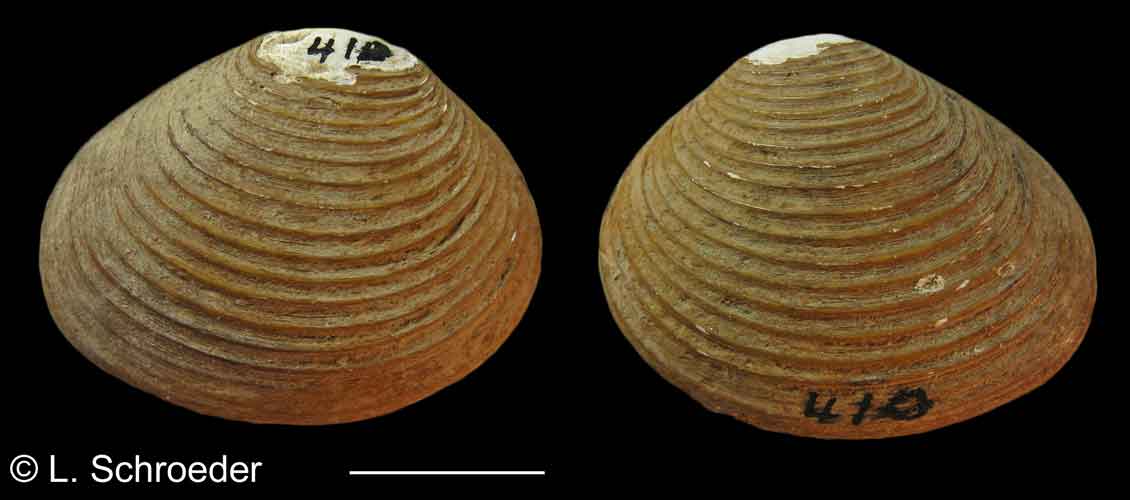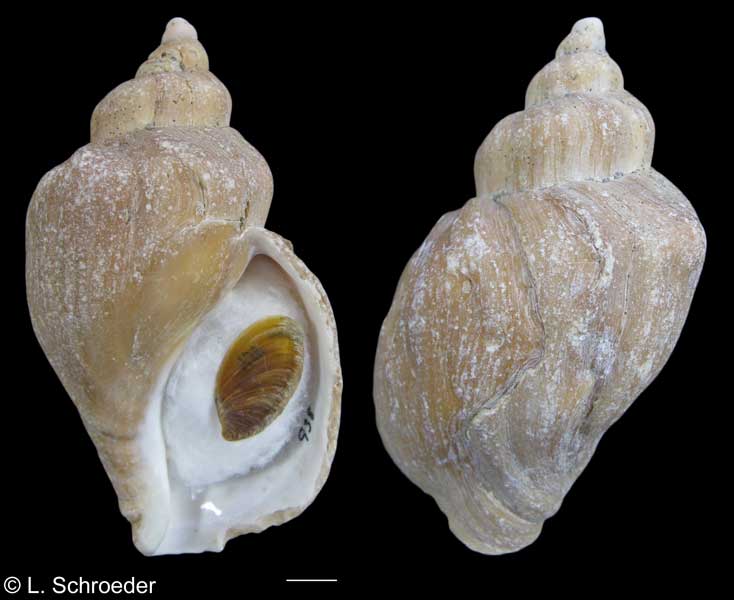Bivalves
Gastropods
Pectinidae
 Chlamys albida (Arnold, 1906)White Scallopsubtidal, 100-200m size to 65mmcentral to northern Alaska, across Bering Sea and south to northern JapanThe shell is white to pink and sometimes is banded. There are 6-12 wide undulations, with numerous imbricated ribs on and between the undulations. It was once considered to be Chlamys islandica, but that is an Atlantic species.(previous names - Pecten hastatus albidus, Pecten erythrocomatus)
Chlamys albida (Arnold, 1906)White Scallopsubtidal, 100-200m size to 65mmcentral to northern Alaska, across Bering Sea and south to northern JapanThe shell is white to pink and sometimes is banded. There are 6-12 wide undulations, with numerous imbricated ribs on and between the undulations. It was once considered to be Chlamys islandica, but that is an Atlantic species.(previous names - Pecten hastatus albidus, Pecten erythrocomatus)
Tellinidae Tellina lutea Woods, 1828
Tellina lutea Woods, 1828
Great Alaskan Tellin intertidal to 80m size to 116mmCook Inlet, AK to Arctic coast; across Bering Sea to Japan & Korea
This is a robust shell. The interior generally has some pink or yellow coloring.
Alaskan Shells
(Bering Sea to the Arctic Ocean)
There are a number of Pacific Northwest shells which range into central and northern Alaskan waters. The
following shells are those species which are found in Alaskan
waters but which do not extend southward into the Pacific Northwest.
Size,
depth and range data for most of the following shells is only
approximate. Due to their remote habitat, our knowledge of many of them
is incomplete.
Carditidae
 Cyclocardia crebricostata (Krause, 1885)Many-Ribbed Carditidsubtidal, 10-260m size to 25mmcentral to northern Alaska, across Bering SeaThis species has about 25 low, rounded ribs with narrow interspaces. The periostracum is thick and fibrous.(synonyms - Cardita crebricostata, Venericardia alaskana)
Cyclocardia crebricostata (Krause, 1885)Many-Ribbed Carditidsubtidal, 10-260m size to 25mmcentral to northern Alaska, across Bering SeaThis species has about 25 low, rounded ribs with narrow interspaces. The periostracum is thick and fibrous.(synonyms - Cardita crebricostata, Venericardia alaskana)
Click on photo to enlarge. Scale line in photo equals 1cm unless otherwise specified.
* Species which are commonly encountered on the beach.
Similipecten greenlandicus (Sowerby, 1842)Greenland Glass-Scallopsubtidal, 19-2560m size to 35mm
Panarctic; Beaufort Sea, AK; North Atlantic to Greenland, Iceland and Norway; an isolated population reported off northern BC
This fragile species is transparent with a fairly smooth surface. The right valve is smaller than the left.
(previous names - Propeamussium greenlandicus, Cyclopecten greenlandicus)
Myidae Mya baxteri Coan & Scott, 1997Deep Softshellsubtidal, 10-100m size to 200mm
Mya baxteri Coan & Scott, 1997Deep Softshellsubtidal, 10-100m size to 200mm
Cold Bay, AK to Nome, AK; across Bering Sea to Kamchatka Peninsula
This shell has a very deep pallial sinus.
(synonyms - Mya intermedia, Mya profundior)

Tridonta montagui (Dillwyn, 1817)Narrow-hinge Astartesubtidal, 10-455m size to 45mm
Circumboreal and panarctic, reaching south to Norton Sound, AK; Kamtchatka; Massachusetts and Scotland
This
species may have variable sculpture. The periostracum may be
light brown to black. The hinge is narrow and the teeth, small.
(synonyms - Asterte montagui, Nicania montagui, Venus montagui)
Astartidae Astarte crenata (J.E. Gray, 1824)Crenulate Astartesubtidal, 10-400m size to 35mmnorth Bering Sea to Pribilof Islands; circumpolar and panarctic; north Atlantic to Massachusettes and NorwayThis
species has closely spaced ribs and a shiny periostracum. The
teeth are small. The inner ventral margin is crenulated.
Astarte crenata (J.E. Gray, 1824)Crenulate Astartesubtidal, 10-400m size to 35mmnorth Bering Sea to Pribilof Islands; circumpolar and panarctic; north Atlantic to Massachusettes and NorwayThis
species has closely spaced ribs and a shiny periostracum. The
teeth are small. The inner ventral margin is crenulated.
(synonym - Nicania crenata)
Lasaeidae Boreacola maltzani (Verkrüzen, 1875)Arctic Montacutid
Boreacola maltzani (Verkrüzen, 1875)Arctic Montacutid
subtidal, 0.5-30m size to 3mm
Beaufort Sea, AK; Norway; likely circumboreal
This tiny species has a highly polished periostracum. The umbones are frequently covered in dark deposits.
(synonym - Boreacola vadosa)
Capulidae
 Nodulotrophon coronatus
Nodulotrophon coronatus
(H.Adams & A.Adams, 1864) Dall's Trophonsubtidal to at least 130m size to at least 50mmAleutians to ArcticThis species has a long siphonal canal with short spines crowning the whorls. (The specimen inphoto has a broken siphonal canal.)
(previous names - Trophon coronatus, Boreotrophon dalli)
Trichotropis insignis (Middendorff, 1849)
Gray Hairysnail
subtidal to 100m size to 25mm
Alaska to northern Japan
This shell is short-spired with a large body whorl.
The
Boreotrophons are rather variable species and are in need of further
study. The species shown here may prove to be variations of other
species and exhibit a much larger range than what is listed. This could
include ranging further south into the Pacific Northwest.
Buccinidae Beringius crebricostatus Dall, 1887Thick-cord Whelksubtidal size to 120mmsouth Bering SeaIt has distinctive thick spiral cords.(synonyms - Chrysodomus crebricostatus)
Beringius crebricostatus Dall, 1887Thick-cord Whelksubtidal size to 120mmsouth Bering SeaIt has distinctive thick spiral cords.(synonyms - Chrysodomus crebricostatus)
Buccinum polare Gray, 1839
Polar Buccinum
subtidal to at least 90m size to 100mm
Aleutians to Arctic, across Bering Sea to Kamchatka;
Siberia; North Atlantic
This species has a distinctive, thin, bumpy periostracum.
The shell is very white with fine spiral lines encircling it.


 Buccinum angulosum Gray, 1839Angular Whelksubtidal
to at least 64m Bering Sea,
Circum-Arctic size to 75mm
Buccinum angulosum Gray, 1839Angular Whelksubtidal
to at least 64m Bering Sea,
Circum-Arctic size to 75mm
This
species is variable in the number and thickness of axial cords.
The angle in the center of the body whorl may be subtle or very
sharp.

 Beringius freilei Dall, 1895subtidal to at least 350m size to 110mmBering Sea to Barents SeaThis is a tall spired species with small, evenly spaced cords.
Beringius freilei Dall, 1895subtidal to at least 350m size to 110mmBering Sea to Barents SeaThis is a tall spired species with small, evenly spaced cords.
Beringius stimpsoni (Gould, 1860)
subtidal to at least 56m size to 110mm
Bering Sea
This species has prominent, angled axial ribs.
(synonyms - Beringius malleatus)
 Buccinum cf. rondinum Dall, 1919subtidal to at least 291m size to at least 45mmSoutheast Bering Sea
Buccinum cf. rondinum Dall, 1919subtidal to at least 291m size to at least 45mmSoutheast Bering Sea
This species has a yellowish-brown periostracum. The shell has fine spiral
lines. The early whorls and top of the body whorl show faint axial ribbing.
 Buccinum sigmatopleura Dall, 1907subtidal to at least 246m size to 70mmAleutians to ArcticThis species has prominent axial ribbing.
Buccinum sigmatopleura Dall, 1907subtidal to at least 246m size to 70mmAleutians to ArcticThis species has prominent axial ribbing.
Muricidae
 Boreotrophon cepula (Sowerby, 1880)
Boreotrophon cepula (Sowerby, 1880)
Scallion Trophon
subtidal to at least 110m size to 40mm
Cook Inlet, Alaska to Arctic, across Bering Sea to Japan
This species has a long, curved siphonal canal with a taller spire and less prominent shoulder spines than N. coronatus.
(previous name - Trophon cepula, Boreotrophon beringi)
 Clinopegma magnum (Dall, 1895)Magna Whelksubtidal to at least 150m size to 114mm
Clinopegma magnum (Dall, 1895)Magna Whelksubtidal to at least 150m size to 114mm
Aleutians to Arctic; across Bering Sea to Japan
This is a sturdy shell with an adherent periostracum.
(Synonym - Ancistrolepis magnum)

 Buccinum costatum Golikov, 1980
Buccinum costatum Golikov, 1980
subtidal to at least 366m size to at least 91mm
Bering Sea
This species has regular, tightly spaced spiral cords
and a light brown periostracum.


 Neptunea (Rugosa-group) ventricosa (Gmelin, 1791)Fat Neptunesubtidal, 17 to 320m Bering Sea, Circumpolar size to 160mm
Neptunea (Rugosa-group) ventricosa (Gmelin, 1791)Fat Neptunesubtidal, 17 to 320m Bering Sea, Circumpolar size to 160mm
This shell is thick and inflated. It can be somewhat variable in appearance.
from central Aleutians
from Sea of Japan
from Sea
of Okhotsk Clinopegma decora (Dall, 1925)
subtidal, 30-300m Bering Sea to Sea of Japan size to 130mm
This species is somewhat variable across its range.
(synonym - Ancistrolepis decora)
Pseudoliomesus nux (Dall, 1907)
Nut Whelk
subtidal to at least 100m size to 35mm
southern Bering Sea to Japan
This small species has a thick, glossy, white lip.
(previous name - Liomesus nux)

 Volutopsius middendorffi (Dall, 1891)
Volutopsius middendorffi (Dall, 1891)
Middendorf's Volute Whelk
subtidal to at least 411m Aleutians to Arctic to Korea size to 124mm
This species has a large body whorl and a yellowish operculum.
Cochlespiridae

shows sexual dimorphism in
aperture
Aforia circinata (Dall, 1873)Keeled Aforiasubtidal to 318m size to 81mmnortheast Gulf of Alaska into Bering Sea; Japan
This species has a thin shell and a tall spire,with
a prominent cord encircling the whorls. Sexual dimorphism
exhibited through the shape of the aperture is very rare in shells.
The above photo shows the male and female forms.

 Pyrulofusus harpa (Mörch, 1857)
Pyrulofusus harpa (Mörch, 1857)
Left-hand Whelk
subtidal, at least 100-267m size to 120mm
Gulf of Alaska to south Bering Sea
This is a naturally sinistral species with strong spiral cords.
 Pyrulofusus dexius (Dall, 1907)Right-handed Whelksubtidal, at least 90-100m size to 160mm
Pyrulofusus dexius (Dall, 1907)Right-handed Whelksubtidal, at least 90-100m size to 160mm
Aleutian Islands; Bering Sea
 Volutopsius fragilis (Dall, 1891)subtidal, 27-400m Bering Sea size to 130mmThis
species has a thin, fragile shell. The body whorl is very large
for it's size.
Volutopsius fragilis (Dall, 1891)subtidal, 27-400m Bering Sea size to 130mmThis
species has a thin, fragile shell. The body whorl is very large
for it's size.
It has a yellowish operculum (not shown here).
Citation: Pacific Northwest Shell Club, www.PNWSC.org
Volutidae Arctomelon tamikoae (Kosuge, 1970)subtidal to at least 402m size to 200mm
Arctomelon tamikoae (Kosuge, 1970)subtidal to at least 402m size to 200mm
Aleutians
This is similar to Arctomelon stearnsi. This species
has vertical ribbing on the whorls.
Neptunea (Multistriata-group) multistriata
(Aurivillius, 1885)
subtidal size to 90mm
Bering Sea, Circumpolar
This page last revised: 6-29-2024

 Pyrulofusus melonis (Dall, 1891)
Pyrulofusus melonis (Dall, 1891)
Melon Shaped Whelk
subtidal to at least 415m Bering Sea to Japan size to 120mm
This species has fine spiral lines and wavy, irregular axial ridges.
(synonym - Volutopsius melonis)
 Volutopsius stefanssoni Dall, 1919
Volutopsius stefanssoni Dall, 1919
Stefansson's Melon Snail
subtidal to at least 102m size to at least 114 mmSoutheast Alaska through Bering Sea to Arctic Alaskan waters
The shell is heavy and pinkish-brown and typically has a high rounded shoulder.

 Pyrulofusus deformis (Reeve, 1847)Sinistral Arctic Whelksubtidal, 98-176m Aleutians to Arctic; Circumpolar size to 170mmThis is a naturally sinistral species. It is a somewhat thin and fragile shell.
Pyrulofusus deformis (Reeve, 1847)Sinistral Arctic Whelksubtidal, 98-176m Aleutians to Arctic; Circumpolar size to 170mmThis is a naturally sinistral species. It is a somewhat thin and fragile shell.
The spiral cords are small and can be very faint.
 Neptunea (Rugosa-group) heros (Gray, 1850)Heros Neptunesubtidal, 20-200m size to 175mm
Neptunea (Rugosa-group) heros (Gray, 1850)Heros Neptunesubtidal, 20-200m size to 175mm
Circumpolar Arctic; Bering Sea to Japan
This species has a fairly thick shell with
distinct shoulder nodes on the body whorl.















































